
- Usage in publication:
-
- Arvonia slate belt
- Modifications:
-
- Original reference
- Biostratigraphic dating
- AAPG geologic province:
-
- Piedmont-Blue Ridge province
Summary:
Pg. 36-43. West of Blue Ridge the Martinsburg shale [Upper and Middle Ordovician] was laid down at about same time as Quantico and Arvonia belts of slate. Age is Late Ordovician (Cincinnatian, probably middle Cincinnatian) based on fossils (identifed by R.S. Bassler, Smithsonian USNM).
Source: Publication; US geologic names lexicon (USGS Bull. 896, p. 78-79).
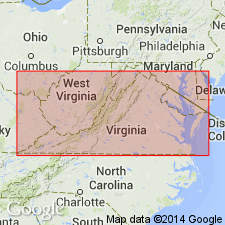
- Usage in publication:
-
- Arvonia slates
- Modifications:
-
- Areal extent
- AAPG geologic province:
-
- Piedmont-Blue Ridge province
Watson, T.L., 1916, Geologic map of Virginia: Virginia Geological Survey
Summary:
[Map explanation states that the Ordovician (Cincinnatian) block "includes the Arvonia and Quantico slates of the Piedmont Plateau province."]
Source: US geologic names lexicon (USGS Bull. 896, p. 78-79).
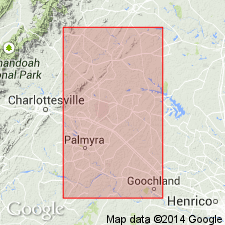
- Usage in publication:
-
- Arvonia slates
- Modifications:
-
- Principal reference
- Dominant lithology:
-
- Slate
- AAPG geologic province:
-
- Piedmont-Blue Ridge province
Summary:
Pg. 841-842. Arvonia slate. Blue slates which unconformably overlie Peters Creek formation and Precambrian granite, with a basal conglomerate present in part of area. Have been previously mapped and described but not named. Writer proposes name Arvonia slates for these beds. Bassler classifies fossils as probably of Chazy [Lower Ordovician] age.
Exposed at Arvonia, Buckingham Co., central VA (James River region).
Source: US geologic names lexicon (USGS Bull. 896, p. 78-79).

- Usage in publication:
-
- Arvonia slates
- Modifications:
-
- Areal extent
- AAPG geologic province:
-
- Piedmont-Blue Ridge province
Summary:
Pg. 119. At the James River in Virginia, Arvonia slates, of Chazyan age, are infolded in a continuation of the Peach Bottom syncline.
Source: US geologic names lexicon (USGS Bull. 896, p. 78-79).
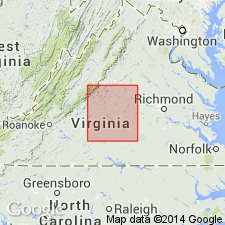
- Usage in publication:
-
- Arvonia slate
- Modifications:
-
- Areal extent
- AAPG geologic province:
-
- Piedmont-Blue Ridge province
Jonas, A.I., 1932, Kyanite in Virginia: Virginia Geological Survey Bulletin, no. 38, 52 p.
Summary:
Pg. 25. Fossils have been found in Arvonia slate by Darton (Amer. Jour. Sci., 3rd ser., v. 44, p. 50-52, 1892) and others in old quarry east of Arvonia Station [Palmyra sheet (1891 ed.), scale 1:125,000, Buckingham County, James River region, central Virginia]. They include crinoids, brachiopods and trilobites of late Ordovician (Maysville) age, according to personal communication from C. Schuchert and R.S. Bassler. Slate of same age occurs near Quantico [Quantico slate] and Dumfries, in northeastern Virginia. The Arvonia slate is similar in character to Peach Bottom slate of Maryland and Pennsylvania, whose age is not known because no fossils have been found in it.
Source: US geologic names lexicon (USGS Bull. 896, p. 78-79).

- Usage in publication:
-
- Arvonia slate*
- Modifications:
-
- Revised
- AAPG geologic province:
-
- Piedmont-Blue Ridge province
Summary:
Pg. 393-412. Arvonia slate. In central Virginia is not restricted to belt of commercial slate but includes a porphyroblastic facies of slate, called knotted slate. Underlies Bremo quartzite (new); overlies Peters Creek formation. Suggested that age may be Silurian or younger.
Source: US geologic names lexicon (USGS Bull. 1200, p. 146-147).

- Usage in publication:
-
- Arvonia Formation
- Modifications:
-
- Age modified
- AAPG geologic province:
-
- Piedmont-Blue Ridge province
Summary:
Pg. 139-141. Arvonia Formation. Probably correlative with Quantico Slate of Pavlides and others (1974, p. 372) and Pavlides (1976, p. 4) in the Quantico and Columbia synclines. Lithologies are strikingly similar. Fossils from the Arvonia indicate a Late Ordovician age.
Source: Publication; GNC index card files (USGS-Reston).
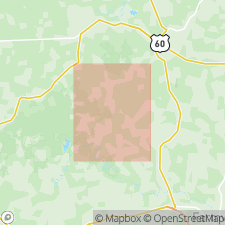
- Usage in publication:
-
- Arvonia Formation
- Modifications:
-
- Mapped
- AAPG geologic province:
-
- Piedmont-Blue Ridge province
Summary:
See also J.F. Conley, 1978, Virginia Div. Min. Res. Pub., no. 7, p. 139-141; J.D. Marr, Jr., 1980, Geol. Willis Mountain quadrangle, Virginia Div. Min. Res. Pub., no. 25; J.F. Conley and J.D. Marr, Jr., 1980, Contrib. geol. IV, Virginia Div. Min. Res. Pub., no. 27.
Arvonia Formation. Upper part, porphyroblastic garnet-mica schist interbedded with light-gray to dark-grayish-green, medium- to coarse-grained metasiltstones and metaclaystones, crinkle-folded and well-foliated, confined to cores of synclines. Middle part, light-yellowish-gray, medium-grained, banded to cross-bedded quartzite, up to 75 feet (23 m) thick; at Willis Mountain is a kyanite quartzite. Lower part, quartz-mica schist with layers of micaceous quartzite and quartz-mica conglomerate, contains massive lenses and stringers of kyanite, base is conglomeratic and includes sillimanite-bearing zones; occurs on flanks of linear ridges held up by quartzites; on eastern flank of Woods Mountain is a kyanite schist and quartzite containing wedge-shaped fining upward sequences of "jelly bean" gravels, fine quartzite, and nearly pure kyanite. Younger than Chopawamsic Formation. Age is considered Middle(?) to Late Ordovician.
Source: Publication.
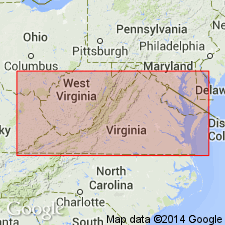
- Usage in publication:
-
- Arvonia Slate*
- Modifications:
-
- Age modified
- Biostratigraphic dating
- AAPG geologic province:
-
- Piedmont-Blue Ridge province
Summary:
Arvonia Slate near Arvonia, Buckingham Co., central VA, contains echinoderm fauna consisting of numerous fragments of large pinnulate camerate crinoid, cyclocystoid marginal rings, two specimens of an ophiuroid, and an undetermined echinoderm. These and associated brachiopods, bryozoans, trilobites, and bivalves suggest a Middle to Late Ordovician age.
Source: GNU records (USGS DDS-6; Reston GNULEX).
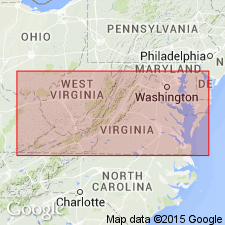
- Usage in publication:
-
- Arvonia Formation
- Modifications:
-
- Revised
- AAPG geologic province:
-
- Piedmont-Blue Ridge province
Summary:
Pg. 39, 40-41 (geol. map), 42. Arvonia Formation. Divided into (descending): (1) metagraywacke; (2) slate; (3) dacite metatuff; (4) quartzite and quartz-muscovite schist; (5) chlorite-muscovite schist and phyllite (previously included in Buffards Formation by Brown, 1969); and (6) conglomeratic chlorite-muscovite schist (previously included in Buffards Formation by Brown, 1969). Overlies Cambrian(?) Chopawamsic Formation; underlies Bremo quartzite southeast of study area. Age is considered Ordovician.
Source: Publication; GNC index card files (USGS-Reston).
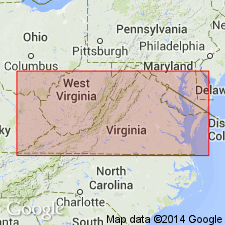
- Usage in publication:
-
- Arvonia Formation
- Modifications:
-
- Revised
- AAPG geologic province:
-
- Piedmont-Blue Ridge province
Summary:
Pg. 23, 24. Arvonia Formation. Includes Buffards Conglomerate Member at base. Unconformably overlies Columbia Granite (454 +/-9 Ma). Correlative with Quantico. Age is considered Middle(?) Ordovician, Late Ordovician, or Silurian(?).
Source: GNC index card files (USGS-Reston).

- Usage in publication:
-
- Arvonia Formation
- Modifications:
-
- Areal extent
- AAPG geologic province:
-
- Piedmont-Blue Ridge province
Summary:
Arvonia Formation is divided into four map units on the VA State map: slate and porphyroblastic schist; porphyroblastic garnet-biotite schist; Bremo quartzite; and kyanite quartzite and schist. The first is described as dominantly dark-gray to grayish-black, lustrous, very fine grained, slate in the northern sector and medium-grained, porphyroblastic garnetiferous biotite schist in the southwestern sector. Discontinuous beds of quartzose muscovite schist, coarse-grained to pebbly micaceous quartzite, and conglomeratic schist occur along the margins of the outcrop belt, stratigraphically at the base of the section. Interbeds of dacite metatuff occur in the western portion of the slate outcrop belt. Graded laminated metasiltstone and metasandstone are interbedded with the slate in the central and eastern portions of the outcrop belt, and these rocks pass into porphyroblastic schists at higher metamorphic grades to the southwest. A distinctive garnet-amphibole quartz interbed occurs south of the James River. The base of the Arvonia is exposed in an old railroad cut near Carysbrook, Fluvanna Co. There, a micaceous quartzite containing quartz pebbles rests on granite of the Carysbrook pluton. The second lithology is described as a porphyroblastic mica schist, characterized by garnet porphyroblasts in an anastomosing greenish-black biotite-rich schistose matrix. Includes quartzose muscovite schist along the western and eastern margins of the outcrop belt. This unit was mapped in strike-belts southwest of, and not physically connected to, the type section at Arvonia. The Bremo quartzite, considered a member of the Arvonia by Smith and others (1964) and Brown (1969), is a light-gray, fine- to medium-grained, thick-bedded and locally cross-bedded quartzite. It includes quartz-muscovite schist, and quartz-pebble conglomerate. Contains crinoid stems and brachiopods. According to Brown (1969), the Bremo occurs locally in the middle or lower part of the Arvonia. The forth map unit is a white to light-gray, medium- to coarse-grained, well-foliated, locally crinkle-folded, quartzose kyanite schist and kyanite-bearing quartzite. Arvonia is correlated with the Quantico Formation and is Late Ordovician in age, based on fossils collected by Watson and Powell (1911) and other workers.
Source: GNU records (USGS DDS-6; Reston GNULEX).
- Usage in publication:
-
- Arvonia Formation*
- Modifications:
-
- Overview
- AAPG geologic province:
-
- Piedmont-Blue Ridge province
GNC Staff, 2012, [U.S. Geologic Names Committee remarks on Ordovician geologic units of the Piedmont-Blue Ridge province]: U.S. Geological Survey, unpublished Geologic Names Committee note
Summary:
Arvonia Formation. Age is considered Late Ordovician (Cincinnatian) based on fossils and stratigraphic relations.
Source: NA
For more information, please contact Nancy Stamm, Geologic Names Committee Secretary.
Asterisk (*) indicates published by U.S. Geological Survey authors.
"No current usage" (†) implies that a name has been abandoned or has fallen into disuse. Former usage and, if known, replacement name given in parentheses ( ).
Slash (/) indicates name conflicts with nomenclatural guidelines (CSN, 1933; ACSN, 1961, 1970; NACSN, 1983, 2005, 2021). May be explained within brackets ([ ]).

